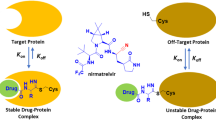Abstract
Mimics of α-helices on protein surfaces have emerged as powerful reagents for antagonizing protein-protein interactions, which are difficult to target with small molecules. Here we describe the design of a cell-permeable synthetic α-helix, based on the guanine nucleotide exchange factor Sos, that interferes with Ras-Sos interaction and downregulates Ras signaling in response to receptor tyrosine kinase activation.


Similar content being viewed by others
Change history
04 August 2011
In the version of this article initially published online, the description of the control analog HBS 7 incorrectly stated that "three alanines were replaced with residues that are important for interaction: Phe929, Glu942 and Asn944." It should have said that in this analog "the residues that are important for interaction, Phe929, Glu942 and Asn944, were replaced with alanine residues." The error has been corrected for the print, PDF and HTML versions of this article.
References
Blume-Jensen, P. & Hunter, T. Nature 411, 355–365 (2001).
Buday, L. & Downward, J. Biochim. Biophys. Acta 1786, 178–187 (2008).
Konstantinopoulos, P.A., Karamouzis, M.V. & Papavassiliou, A.G. Nat. Rev. Drug Discov. 6, 541–555 (2007).
Kortemme, T., Kim, D.E. & Baker, D. Sci. STKE 2004, pl2 (2004).
Hall, B.E., Yang, S.S., Boriack-Sjodin, P.A., Kuriyan, J. & Bar-Sagi, D. J. Biol. Chem. 276, 27629–27637 (2001).
Patgiri, A., Jochim, A.L. & Arora, P.S. Acc. Chem. Res. 41, 1289–1300 (2008).
Henchey, L.K., Porter, J.R., Ghosh, I. & Arora, P.S. ChemBioChem 11, 2104–2107 (2010).
Henchey, L.K. et al. J. Am. Chem. Soc. 132, 941–943 (2010).
Sondermann, H. et al. Cell 119, 393–405 (2004).
Chakrabartty, A., Kortemme, T. & Baldwin, R.L. Protein Sci. 3, 843–852 (1994).
Patgiri, A., Menzenski, M.Z., Mahon, A.B. & Arora, P.S. Nat. Protoc. 5, 1857–1865 (2010).
Boriack-Sjodin, P.A., Margarit, S.M., Bar-Sagi, D. & Kuriyan, J. Nature 394, 337–343 (1998).
Sacco, E. et al. FEBS Lett. 579, 6851–6858 (2005).
Ito, Y. et al. Biochemistry 36, 9109–9119 (1997).
Moellering, R.E. et al. Nature 462, 182–188 (2009).
Boykevisch, S. et al. Curr. Biol. 16, 2173–2179 (2006).
Gureasko, J. et al. Nat. Struct. Mol. Biol. 15, 452–461 (2008).
Kolch, W. Nat. Rev. Mol. Cell Biol. 6, 827–837 (2005).
Kholodenko, B.N., Hancock, J.F. & Kolch, W. Nat. Rev. Mol. Cell Biol. 11, 414–426 (2010).
Harrison, R.S. et al. Proc. Natl. Acad. Sci. USA 107, 11686–11691 (2010).
Horne, W.S. et al. Proc. Natl. Acad. Sci. USA 106, 14751–14756 (2009).
Cummings, C.G. & Hamilton, A.D. Curr. Opin. Chem. Biol. 14, 341–346 (2010).
McKay, M.M. & Morrison, D.K. Oncogene 26, 3113–3121 (2007).
Lemmon, M.A. & Schlessinger, J. Cell 141, 1117–1134 (2010).
Acknowledgements
This work was supported by the US National Institutes of Health (GM073943 to P.S.A. and GM078266 and an ARRA stimulus supplement (GM078266S1) to D.B.-S.). A.P. thanks New York University for the Margaret and Herman Sokol Fellowship. NMR data were collected at the New York Structural Biology Center, a Strategically Targeted Academic Research (STAR) center supported by the New York State Office of Science, Technology and Academic Research. We thank C. Lin (New York University) and A. Natarajan and R. Ghosh (City College, City University of New York) for help with the NMR studies.
Author information
Authors and Affiliations
Contributions
A.P., K.K.Y., P.S.A. and D.B.-S. designed experiments, analyzed data and wrote the paper, and A.P. and K.K.Y. performed experiments.
Corresponding authors
Ethics declarations
Competing interests
The authors declare no competing financial interests.
Supplementary information
Supplementary Text and Figures
Supplementary Methods and Supplementary Results (PDF 8228 kb)
Rights and permissions
About this article
Cite this article
Patgiri, A., Yadav, K., Arora, P. et al. An orthosteric inhibitor of the Ras-Sos interaction. Nat Chem Biol 7, 585–587 (2011). https://doi.org/10.1038/nchembio.612
Received:
Accepted:
Published:
Issue Date:
DOI: https://doi.org/10.1038/nchembio.612
- Springer Nature America, Inc.
This article is cited by
-
From bench to bedside: current development and emerging trend of KRAS-targeted therapy
Acta Pharmacologica Sinica (2024)
-
A Review of the in Silico Design and Development Approaches of Ras-Specific Anticancer Therapeutics
International Journal of Peptide Research and Therapeutics (2023)
-
Chemical acylation of an acquired serine suppresses oncogenic signaling of K-Ras(G12S)
Nature Chemical Biology (2022)
-
Controlling oncogenic KRAS signaling pathways with a Palladium-responsive peptide
Communications Chemistry (2022)
-
KRAS mutation: from undruggable to druggable in cancer
Signal Transduction and Targeted Therapy (2021)





